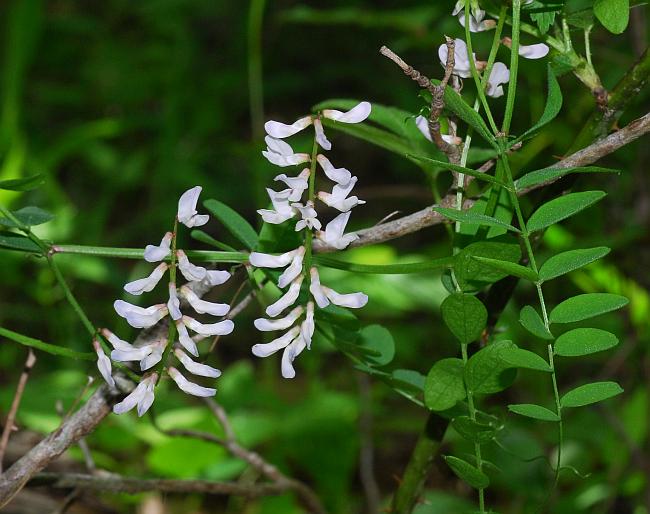Vicia caroliniana Walter
Wood Vetch

Native
CC = 6
CW = 5
MOC = 33
© SRTurner
Vicia caroliniana WalterWood Vetch | |
 |
Native CC = 6 CW = 5 MOC = 33 |
© SRTurner |
|
Family - Fabaceae/Faboideae Habit - Rhizomatous perennial forb. Stems - Trailing or climbing, to 1 m, sparsely pubescent with fine hairs, sometimes almost glabrous at maturity. Leaves - Alternate, stipulate, petiolate, even-pinnately compound. Petioles to 6 mm. Tendrils present at leaf apex, mostly unbranched. Leaves with 8-14 leaflets. Stipules 2-4 mm long. Leaflets 8-20 mm long, 2-8 mm wide, narrowly oblong to narrowly elliptic or oblong-lanceolate, rounded or angled at the base, variously rounded to bluntly or sharply pointed or occasionally nearly truncate at the tip, the midvein often extended as a minute, sharp point at the very tip, the surfaces finely hairy
Inflorescence - Relatively open racemes, the stalk 2-4 cm long, the flowers 8-20, each with a stalk 0.5-1.5 mm long.
Flowers - Calyces usually finely hairy, the tube 1.5-2.0 mm long, the base somewhat oblique and sometimes slightly pouched on 1 side, the attachment appearing basal but off-center, the lobes 0.5-1.0 mm long, subequal, the upper pair only slightly shorter than the lowermost, triangular to broadly triangular. Corollas papilionaceous, 8-12 mm long, white, sometimes tinged with pale lavender, the keel usually strongly bluish-tinged toward the tip, the banner bent or curved upward at or above the midpoint, strongly curved around the wings and keel. Stamens with the fused portion 5-6 mm long, the free portion 1-2 mm long. Style encircled by a dense ring of short hairs toward the tip.
Fruits - Legumes 15-30 mm long, 4-6 mm wide, short-stalked, glabrous, straw-colored to light brown at maturity, 4-9-seeded. Seeds 2.5-4.0 mm long, reddish brown to purplish brown, sometimes nearly black, sometimes with darker mottling, more or less circular in outline, slightly to strongly flattened, the attachment scar slightly raised, yellowish brown to straw-colored, extending about 3/4 the circumference of the seed. Flowering - April - May. Habitat - Forests, glades, bluffs, pond margins, streambanks, fencerows. Origin - Native to the U.S. Lookalikes - None. Other info. - This small twining plant is found in the southern half of Missouri, and across much of the eastern half of the continental U.S. There are some disjunctions in the U.S. population. The plant favors relatively undisturbed areas, and is easily overlooked. It is identified by its alternate, compound leaves and stalked, open inflorescences of numerous white flowers. Unlike some other members of the genus, this species is conservative and not at all weedy. Photographs taken at Caney Mountain Conservation Area, Ozark County, MO, 4-13-2012, and at Meramec State Park, Franklin County, MO, 5-7-2019 and 4-16-2020 (SRTurner). |